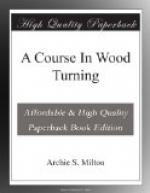The round nose, square nose, spear point, right skew and left skew are scraping tools, used chiefly in pattern work and sometimes in face-plate work. They are sharpened on one side only, and the bevel is about twice the thickness of the chisel at the point where sharpened. These tools should be slightly hollow ground to facilitate the whetting. Scraping tools become dull quite easily as their edges are in contact with the wood almost at right angles. After sharpening, the edges of these tools may be turned with a burnisher or the broad side of a skew chisel in the same manner that the edge of a cabinet scraper is turned though not nearly to so great a degree. This will help to keep the tool sharp for, as the edge wears off, the tool sharpens itself to a certain extent. The chisel is of harder material than a cabinet scraper so that it will not stand a great amount of turning over on the edge. Small pieces will be broken out, unless a flat surface is rubbed against the edge at a more acute angle than was used in the whetting. If a narrow burnisher is used, pieces are more likely to be broken out from the sharp edge and thus make the tool useless.
CHAPTER IV
SPINDLE TURNING
Spindle turning is the term applied to all work done on a lathe in which the stock to be worked upon is held firmly between the live and dead centers. There are two methods in common use in wood turning: first, the scraping or pattern-makers’ method; and second, the cutting method. Each has its advantages and disadvantages, but it is necessary that both be learned in order to develop a well rounded turner. Care should be exercised, however, that each method be used in its proper place. The first is slower, harder on the cutting edge of tools, and less skill is required to obtain accurate work; the second is faster, easier on the cutting edge of tools, and the accuracy of results obtained depends upon the skill acquired. As skill is the one thing most sought for in high school work, the use of the cutting method is advocated entirely for all spindle turning and, with but few exceptions, for face-plate and chuck turning.
TO CENTER STOCK
If the wood to be turned is square or rectangular in shape the best way to locate the center is to draw diagonals across the end of the stock. The point of intersection locates the center.
CLAMPING STOCK IN THE LATHE
Take the live center from the spindle and with a wooden mallet drive the spur deep into the wood. Never drive the wood onto the live center while in the spindle because serious injury may be done the machine by such practice. When extremely hard wood is being used, it is a good practice to make saw cuts along the diagonal lines and bore a hole at the intersection, thus allowing the spur to enter the wood more freely. Oil the




